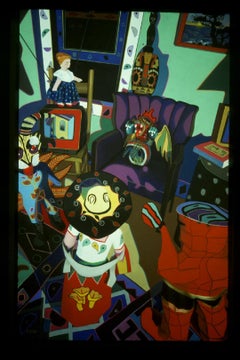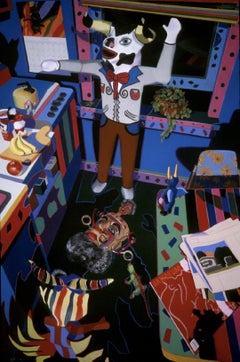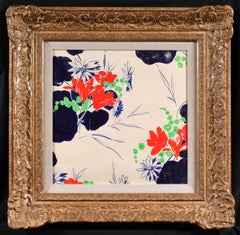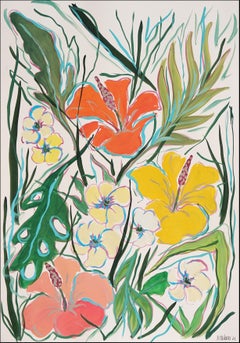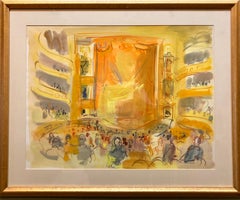Fauvist Interior Drawings and Watercolors
to
2
Overall Width
to
Overall Height
to
2
156
133
94
54
23
23
11
9
9
6
5
1
2
2
2
2
1
1
1
1
1
2
2
2
2
Style: Fauvist
Practical Advice on Waiting, bright colors, domestic, Latin objects
Located in Brooklyn, NY
Works
Her pastel-on-sandpaper series, "Domestic Threats" and "Black Paintings", both use cultural objects as surrogates for human beings acting in mysterious, highly charged narratives.[9][10]
Rachko also has created a series of photographs entitled "Gods and Monsters".[11] In these chromogenic prints, she is "painting with a camera," creating variations that free the camera from being a mechanical recording device of what lies before it. She prints all of these images by hand.
The earlier "Domestic Threats" pastel-on-sandpaper paintings used her West Village apartment or her 1932 Sears house in Virginia as a backdrop. The "Black Paintings" series grew directly from "Domestic Threats". In the "Black Paintings," the figures (actors) take center stage. All background details, furniture, rugs, etc. have been eliminated and replaced by intense dark black pastel. Each painting takes months to complete as she slowly builds up as many as 30 layers of soft pastel.
Her long-standing fascination with traditional masks progressed in the spring of 2017 when she visited the National Museum of Ethnography and Folklore in La Paz, Bolivia where one exhibition included more than fifty festival masks. The resulting series is entitled “Bolivianos”.[12]
She has also written an e-book, From Pilot to Painter[13] and writes a regular blog, Barbara Rachko...
Category
Early 2000s Fauvist Interior Drawings and Watercolors
Materials
Pastel
He Was So in Need of Botany, bright colors, domestic, Latin objects
Located in Brooklyn, NY
Price and size includes frames (maple wood with white mats).
Artwork 58" x 38"
Her pastel-on-sandpaper series, "Domestic Threats" and "Black Paintings", both use cultural objects as surrogates for human beings acting in mysterious, highly charged narratives.[9][10]
Rachko also has created a series of photographs entitled "Gods and Monsters".[11] In these chromogenic prints, she is "painting with a camera," creating variations that free the camera from being a mechanical recording device of what lies before it. She prints all of these images by hand.
The earlier "Domestic Threats" pastel-on-sandpaper paintings used her West Village apartment or her 1932 Sears house in Virginia as a backdrop. The "Black Paintings" series grew directly from "Domestic Threats". In the "Black Paintings," the figures (actors) take center stage. All background details, furniture, rugs, etc. have been eliminated and replaced by intense dark black pastel. Each painting takes months to complete as she slowly builds up as many as 30 layers of soft pastel.
Her long-standing fascination with traditional masks progressed in the spring of 2017 when she visited the National Museum of Ethnography and Folklore in La Paz, Bolivia where one exhibition included more than fifty festival masks. The resulting series is entitled “Bolivianos”.[12]
She has also written an e-book, From Pilot to Painter[13] and writes a regular blog, Barbara Rachko...
Category
Early 2000s Fauvist Interior Drawings and Watercolors
Materials
Pastel
Related Items
Projet de Tissus - Fauvist Flowers Watercolor & Gouache by Raoul Dufy
By Raoul Dufy
Located in Marlow, Buckinghamshire
Botanical watercolour and gouache on paper circa 1920 by French fauvist painter Raoul Dufy. The work depicts flowers in red, blue and green. This work was executed by Dufy as a fabric design.
Dimensions:
Framed: 19.5"x19.5"
Unframed: 12"x12"
Provenance:
Private collection of works by Raoul Dufy for Bianchini Ferier
Bianchini Ferrier Collection - Christie's London - July 2001
SF Fall Show
Raoul Dufy was one of a family of nine children, including five sisters and a younger brother, Jean Dufy, also destined to become a painter. Their father was an accountant in the employ of a major company in Le Havre. The Dufy family was musically gifted: his father was an organist, as was his brother Léon, and his youngest brother Gaston was an accomplished flautist who later worked as a music critic in Paris. Raoul Dufy's studies were interrupted at the age of 14, when he had to contribute to the family income. He took a job with an importer of Brazilian coffee, but still found time from 1892 to attend evening courses in drawing and composition at the local college of fine arts under Charles Marie Lhullier, former teacher of Othon Friesz and Georges Braque. He spent his free time in museums, admiring the paintings of Eugène Boudin in Le Havre and The Justice of Trajan in Rouen. A municipal scholarship enabled him to leave for Paris in 1900, where he lodged initially with Othon Friesz. He was accepted by the École des Beaux-Arts, where he studied under Léon Bonnat, whose innate conservatism prompted Dufy to remark later that it was 'good to be at the Beaux-Arts providing one knew one could leave'.
And leave he did, four years later, embarking with friends and fellow students on the rounds of the major Paris galleries - Ambroise Vollard, Durand-Ruel, Eugène Blot and Berheim-Jeune. For Dufy and his contemporaries, Impressionism represented a rejection of sterile academism in favour of the open-air canvases of Manet, the light and bright colours of the Impressionists, and, beyond them, the daringly innovative work of Gauguin and Van Gogh, Seurat, Cézanne, Toulouse-Lautrec and others. Dufy was an out-and-out individualist, however, and was not tempted to imitate any of these artists. He produced, between 1935 and 1937, Fée Electricité (Spirit of Electricity), the emblem for the French utilities company Electricité de France (EDF).
Dufy visited the USA for the first time in 1937, as a member of the Carnegie Prize jury. In 1940, the outbreak of war (and his increasingly rheumatic condition) persuaded him to settle in Nice. When he eventually returned to Paris 10 years later, his rheumatism had become so debilitating that he immediately left for Boston to follow a course of pioneering anti-cortisone treatment. He continued working, however, spending time first in Harvard and then in New York City before moving to the drier climate of Tucson, Arizona. The cortisone treatment was by and large unsuccessful, although he did recover the use of his fingers. He returned to Paris in 1951 and decided to settle in Forcalquier, where the climate was more clement. Within a short time, however, he was wheelchair-bound. He died in Forcalquier in March 1953 and was buried in Cimiez.
Between 1895 and 1898, Raoul Dufy painted watercolours of landscapes near his native Le Havre and around Honfleur and Falaise. By the turn of the century, however, he was already painting certain subjects that were to become hallmarks of his work - flag-decked Parisian cityscapes, Normandy beaches teeming with visitors, regattas and the like, including one of his better-known early works, Landing Stage at Ste-Adresse. By 1905-1906 Friesz, Braque, Matisse, Derain, Vlaminck, Van Dongen and Rouault were described collectively as Fauves (the wild beasts). What they had in common was a desire to innovate, but they felt constrained nonetheless to meet formally to set out the guiding principles of what promised to be a new 'movement'. Dufy quickly established that those principles were acceptable; moreover, he was most impressed by one particular painting by Henri Matisse ( Luxury, Calm and Voluptuousness) which, to Dufy, embodied both novelty and a sense of artistic freedom. Dufy promptly aligned himself with the Fauves. Together with Albert Marquet in particular, he spent his time travelling the Normandy coast and painting views similar...
Category
1920s Fauvist Interior Drawings and Watercolors
Materials
Paper, Watercolor, Gouache
$12,560
H 19.5 in W 19.5 in
Fauvist Style Illustration Painting, Tropical Hibiscus Bloom, Coral Tones, Paper
Located in Barcelona, ES
"Tropical Hibiscus Bloom II" is an abstract expressionist painting by Romina Milano where a dance of black gestures unfolds across colorful brushstrokes infused with raw emotion.
R...
Category
2010s Fauvist Interior Drawings and Watercolors
Materials
India Ink, Acrylic, Watercolor
$680 Sale Price
20% Off
H 40 in W 28 in
Illustration Style Still Life Painting of Pink Dragon Fruit Tree, Botanical Art
Located in Barcelona, ES
"Dragon Fruit Bush" is an abstract expressionist painting by Romina Milano where a dance of black gestures unfolds across colorful brushstrokes infused with raw emotion.
Romina Mil...
Category
2010s Fauvist Interior Drawings and Watercolors
Materials
India Ink, Acrylic, Rag Paper
L V Guirand de Scevola (1871-1950) A Man writing at his desk , Signed pastel
Located in Paris, FR
Lucien-Victor Guirand de Scevola (1871-1950)
A Man writing at his desk, 18th century interior scene
Pastel on paper
Signed upper right
20.5 x 15.8 cm
Framed under glass : 37 x 31.5 cm
It is known that Guirand de Scevola was very interested in the Palace of Versailles and its Old Regime atmosphere, that he often painted it and that he participated in the Versailles Revival movement at the beginning of the century. This probably led him to paint scenes in the 18th century style, for which he was particularly well known and which are still sought after.
What is striking is the modernity of the execution of our pastel, which obviously contrasts with its subject in the style of the 18th century. Guirand de Scevoal is a great colourist and he proves it here with eclat, by building up his composition with white pastel highlights, contrasting with brown and black. There is something of the northern painters in this treatment of light. All this, as always with him, is very subtle. The light radiating from the window is almost an abstract notation, but it gives meaning to this interior scene.
Lucien-Victor Guirand de Scévola ( 1871 – 1950) was a French painter.
He was student of Fernand Cormon and Pierre Dupuis...
Category
1920s Fauvist Interior Drawings and Watercolors
Materials
Pastel
fruit still life original oil on canvas painting
By Lluis Mercader
Located in Barcelona, Barcelona
Lluís Mercader (Barcelona, 1898 - 1959) was a Spanish painter. Trained in Paris and Munich, he exhibited individually at the Dalmau Galleries in Barcelona (1925) and collectively ...
Category
1950s Fauvist Interior Drawings and Watercolors
Materials
Canvas, Oil
$318 Sale Price
46% Off
H 7.49 in W 9.45 in
Antique Floral Still Life with Tulips and Irises in Gouache on Paper
Located in Soquel, CA
Antique Floral Still Life with Tulips and Irises in Gouache on Paper
Finely detailed still life by Charlotte Siemers (19th Century). Several flowers are shown in a lush bouquet. Flo...
Category
1860s Fauvist Interior Drawings and Watercolors
Materials
Paper, Gouache
$1,200
H 27 in W 22 in D 1.25 in
Interior Scene
Located in Astoria, NY
Robert O'Meara (American, 1957-2024), Interior Scene, Pastel on Paper, depicting doorway and chair, signed lower left, white painted wood frame. Image: 27" H x 21.25" W; frame: 30" H...
Category
Late 20th Century Fauvist Interior Drawings and Watercolors
Materials
Paper, Pastel
Still life flowers oil on canvas painting fauvist
By Jordi Curos
Located in Barcelona, Barcelona
Jordi Curós Ventura (1930-2007) - Still life
Oil on canvas.
Canvas measurements 35x27 cm.
Frameless.
Jordi Curós Ventura (Olot, Girona, March 4, 1930) is a Spanish painter.
He trai...
Category
1970s Fauvist Interior Drawings and Watercolors
Materials
Canvas, Oil
$294 Sale Price
37% Off
H 13.78 in W 10.63 in
Fleurs et Papillons - Fauvist Flowers Watercolor & Gouache by Raoul Dufy
By Raoul Dufy
Located in Marlow, Buckinghamshire
Botanical watercolour and gouache on paper circa 1920 by French fauvist painter Raoul Dufy. The work depicts flowers in red and butterflies in blues, yellows, black and white. This work was executed by Dufy as a fabric design.
Dimensions:
Framed: 17"x27"
Unframed: 10"x20"
Provenance:
Private collection of works by Raoul Dufy for Bianchini Ferier
Bianchini Ferrier Collection - Christie's London - July 2001
SF Fall Show
Raoul Dufy was one of a family of nine children, including five sisters and a younger brother, Jean Dufy, also destined to become a painter. Their father was an accountant in the employ of a major company in Le Havre. The Dufy family was musically gifted: his father was an organist, as was his brother Léon, and his youngest brother Gaston was an accomplished flautist who later worked as a music critic in Paris. Raoul Dufy's studies were interrupted at the age of 14, when he had to contribute to the family income. He took a job with an importer of Brazilian coffee, but still found time from 1892 to attend evening courses in drawing and composition at the local college of fine arts under Charles Marie Lhullier, former teacher of Othon Friesz and Georges Braque. He spent his free time in museums, admiring the paintings of Eugène Boudin in Le Havre and The Justice of Trajan in Rouen. A municipal scholarship enabled him to leave for Paris in 1900, where he lodged initially with Othon Friesz. He was accepted by the École des Beaux-Arts, where he studied under Léon Bonnat, whose innate conservatism prompted Dufy to remark later that it was 'good to be at the Beaux-Arts providing one knew one could leave'.
And leave he did, four years later, embarking with friends and fellow students on the rounds of the major Paris galleries - Ambroise Vollard, Durand-Ruel, Eugène Blot and Berheim-Jeune. For Dufy and his contemporaries, Impressionism represented a rejection of sterile academism in favour of the open-air canvases of Manet, the light and bright colours of the Impressionists, and, beyond them, the daringly innovative work of Gauguin and Van Gogh, Seurat, Cézanne, Toulouse-Lautrec and others. Dufy was an out-and-out individualist, however, and was not tempted to imitate any of these artists. He produced, between 1935 and 1937, Fée Electricité (Spirit of Electricity), the emblem for the French utilities company Electricité de France (EDF).
Dufy visited the USA for the first time in 1937, as a member of the Carnegie Prize jury. In 1940, the outbreak of war (and his increasingly rheumatic condition) persuaded him to settle in Nice. When he eventually returned to Paris 10 years later, his rheumatism had become so debilitating that he immediately left for Boston to follow a course of pioneering anti-cortisone treatment. He continued working, however, spending time first in Harvard and then in New York City before moving to the drier climate of Tucson, Arizona. The cortisone treatment was by and large unsuccessful, although he did recover the use of his fingers. He returned to Paris in 1951 and decided to settle in Forcalquier, where the climate was more clement. Within a short time, however, he was wheelchair-bound. He died in Forcalquier in March 1953 and was buried in Cimiez.
Between 1895 and 1898, Raoul Dufy painted watercolours of landscapes near his native Le Havre and around Honfleur and Falaise. By the turn of the century, however, he was already painting certain subjects that were to become hallmarks of his work - flag-decked Parisian cityscapes, Normandy beaches teeming with visitors, regattas and the like, including one of his better-known early works, Landing Stage at Ste-Adresse. By 1905-1906 Friesz, Braque, Matisse, Derain, Vlaminck, Van Dongen and Rouault were described collectively as Fauves (the wild beasts). What they had in common was a desire to innovate, but they felt constrained nonetheless to meet formally to set out the guiding principles of what promised to be a new 'movement'. Dufy quickly established that those principles were acceptable; moreover, he was most impressed by one particular painting by Henri Matisse ( Luxury, Calm and Voluptuousness) which, to Dufy, embodied both novelty and a sense of artistic freedom. Dufy promptly aligned himself with the Fauves. Together with Albert Marquet in particular, he spent his time travelling the Normandy coast and painting views similar...
Category
1920s Fauvist Interior Drawings and Watercolors
Materials
Paper, Watercolor, Gouache
Portrait of Young Woman, Raoul Dupoux
Located in Fairfield, CT
Artist: Raoul Dupoux (1906-1988)
Title: Untitled
Year: circa 1965
Medium: Watercolor and pastel on wove paper
Size: 26 x 27 inches
Condition: Good
Inscrip...
Category
1960s Fauvist Interior Drawings and Watercolors
Materials
Pastel, Watercolor
$2,000 Sale Price
20% Off
H 13.75 in W 9.25 in
Abstract Still Life with Fruit in Watercolor on Paper
By Les Anderson
Located in Soquel, CA
Abstract Still Life with Fruit in Watercolor on Paper
Colorful still life with fruit by Les (Leslie Luverne) Anderson (American, 1928-2009). Several pieces of fruit appear to be sitting on a table with a purple cloth. The scene is highly abstracted, straddling the line between impressionism and non-representational. The background is brightly colored, adding vibrancy to the scene.
Signed on verso and acquired from the estate of Les Anderson in Monterey, California.
Unframed.
Paper size: 14"H x 20"W
Les (Leslie Luverne) Anderson(American, 1928-2009) owned and operated the Bear Flag Gallery in San Juan...
Category
1980s Fauvist Interior Drawings and Watercolors
Materials
Watercolor, Laid Paper
$475
H 14 in W 20 in D 0.03 in
Mid Century Fuji Apples Still Life with Plaid Cloth
Located in Soquel, CA
Beautiful oil painting of a basket of Fuji apples with a plaid cloth hanging behind by Helen Gleiforst (American, 1903-1997). Signed "Gleiforst" lower right. Unframed. Image, 24"H x ...
Category
1950s Fauvist Interior Drawings and Watercolors
Materials
Masonite, Oil
$1,920 Sale Price
20% Off
H 27.25 in W 24.25 in D 1 in
Previously Available Items
French Fauvist Gouache and Watercolor Painting Paris Opera or Theater Interior
By Roger Bertin
Located in Surfside, FL
Wonderful European Fauvist theatre interior. Roger Bertin was born in Rue Gabrielle in Montmartre, Paris in 1915, and lived in the same house all his life. His godfather was the poet...
Category
Mid-20th Century Fauvist Interior Drawings and Watercolors
Materials
Watercolor, Gouache, Archival Paper
Fauvist interior drawings and watercolors for sale on 1stDibs.
Find a wide variety of authentic Fauvist interior drawings and watercolors available for sale on 1stDibs. Works in this style were very popular during the 21st Century and Contemporary, but contemporary artists have continued to produce works inspired by this movement. Many Pop art paintings were created by popular artists on 1stDibs, including and Barbara Rachko. Frequently made by artists working with Crayon, and Pastel and other materials, all of these pieces for sale are unique and have attracted attention over the years. Not every interior allows for large Fauvist interior drawings and watercolors, so small editions measuring 50 inches across are also available. Prices for interior drawings and watercolors made by famous or emerging artists can differ depending on medium, time period and other attributes. On 1stDibs, the price for these items starts at $25,000 and tops out at $25,000, while the average work sells for $25,000.
